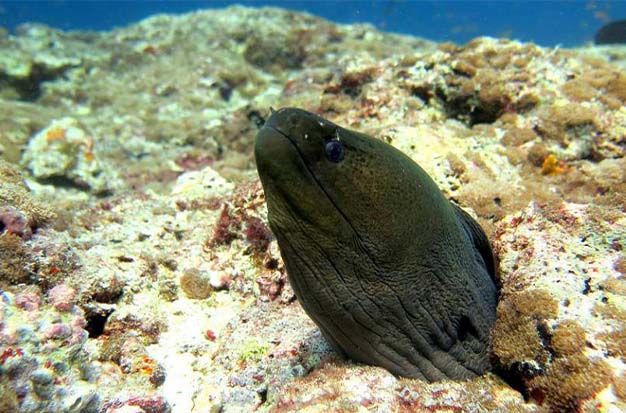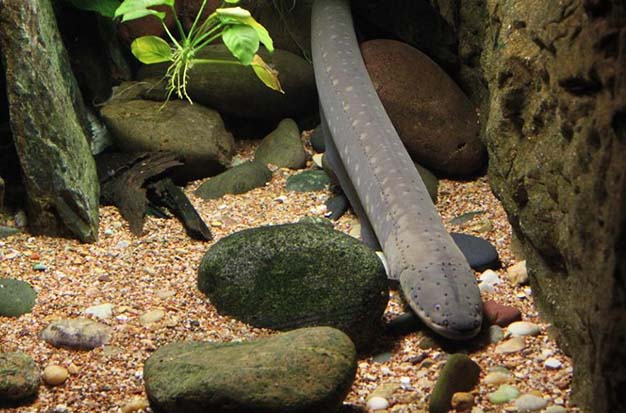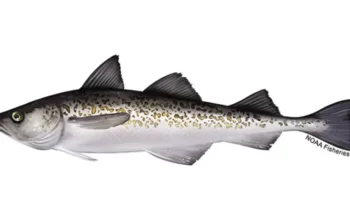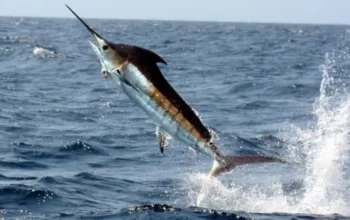Try freshwater eel fishing in North America and Europe if you want a challenge. Knowing when to fish for them and what they enjoy eating will make catching eels simple. Eels can be caught both during the day and at night, and the best time to do so is in the summer. Make your cast after you have tied your weight and hooks to your line and baited your hook with a big nightcrawler. Set your hook and brace yourself for a fight as soon as you sense a nibble!
Table of Contents
What Are Freshwater Eels?
Freshwater eels are nocturnal, which means they hunt at night while using their keen sense of smell to make up for their rather poor vision. All of the time they spend in freshwater and during their migration to the ocean to spawn, freshwater eels are catadromous.
Anguillidae, a family, and genus that includes the true freshwater eels, is their home. Anguilla is a genus that contains 15 to 20 freshwater eel species, including the well-known American, Moray, Spaghetti, and European eels. Freshwater eels belonging to the Anguillidae family, which have scales on their bodies unlike other eels, are an important food source in some regions of the world, particularly in Europe where they are raised on extensive farms.
Only a small percentage of freshwater aquarium elk species are hobbyists. The most well-known of these are spiny eels from the genus Mastacembelidae, including the tire track eel and fire eel.
Some Fun Facts About Freshwater Eels
These fascinating and entertaining tidbits about freshwater aquarium eels are presented.
Eels Are Just Elongated Versions Of Fish
You might be surprised to learn that due to their uncanny resemblance, eels and snakes were frequently confused in the past. But based on their anatomy, they are simply a longer species of fish.
Eels, on the other hand, differ from fish in a number of ways, including the absence of pectoral fins in some eels and pelvic fins. Additionally, the dorsal fins and anal of eels are combined with the tail to form a single strip that extends along the majority of the eels’ length.
Freshwater Eels Are Diverse
There are about 800 different species of eels, according to research. 110 genera, 19 families, and four suborders that we term eels.
Eels Are Ardent Swimmers
Species of freshwater eels are at the bottom. They prefer to bury themselves in the substrate in holes, your tank’s bottom, and other secret locations. They enjoy going deeper into the soil and the plants to fully exploit the opportunity to occasionally attack their prey by surprise.
Eels Are A Favorite Treat
Eels are a common food in some cultures, including Chinese, Japanese, and Korean. Interesting enough?
That’s Not All.
Eels are a common dish in these cultures, and it is much more expensive. Only a kilogram of eels would run you about 1000 HKD in Hong Kong. That’s because eels, especially some species, like European eels, jellied eels, longfin eels, etc., are known to increase stamina and energy levels.
Below 41°, Eels Go Torpor
Freshwater eel species submerge themselves in the mud and enter a stage known as torpor during severe winters when the temperature drops below 41°F or 5°C.
Eels Can Swim Backward
The eel has an attenuately shaped body that begins as a long, slimy body and ends in a powerful tail. Freshwater eels can wriggle and swim backward after their prey as a result of their unique body shape.
Eels Could Easily Kill You
Ever questioned why eel is always served cooked?
This is due to the fact that eel blood is extremely poisonous and may cause your death. An extremely toxic protein found in the blood of eels can cause sudden death by contracting the heart and other body muscles.
Types Of Freshwater Eel
Tire Track Eel
The unusual dark markings that run down the back and sides of this species’ (Mastacembelus favus) sandy-colored body are where it gets its name. A large tank is necessary because it can grow to be 28 inches long in a home aquarium.
Zig Zag Eel
Since they resemble the Tire Track, they are frequently confused with them. The main distinction is where on the body the patterns are located; the Zig Zag patterns can only be found on the top two-thirds of the body. This species (Mastacembelus armatus) can also reach an enormous 35 inches in length and has an 18-year lifespan.
Peacock Eel
A yellow stripe runs along the body of this species, Macrognathus siamensis, which has a light greenish-brown body color. They are diminutive aquarium species that typically reach heights of about 11 inches. A 35-gallon aquarium will do.
Black Spotted Eel
The Black Spotted Eel belongs to the Mastacembelidae family, just like the two species before it. This is the family of spiny eels, which are not actual eels. When they are young, all three species are confused for one another, but when they are adults, the Black Spotted species grows black spots all over its body rather than a reticulated pattern. Mastacembelus dayi, a member of this species has a 20-inch growth rate and an 18-year life span.
Freshwater Snowflake Eel
Contrary to its name, this species is actually brackish rather than freshwater. It is on this list because it returns to freshwater rivers to breed and spawn. Gymnothorax tile is a true Moray Eel species that can only endure in freshwater for brief periods of time. They won’t live as long if kept in freshwater for extended periods of time. They require a minimum of a 35-gallon tank and can grow to be 23 inches long.

Electric Eel
These fish can generate at least 500 volts of electricity, so they are not for the faint of heart. These creatures have been known to render humans unconscious for a period of time long enough for them to drown. All of the bodies of Electrophorus electrics are a uniform dark grey color. They require a tank that is at least 200 gallons in size because they can grow up to 8 feet long.
Freshwater Dragon Eel
Two different species, neither of which are true eels but go by the name “freshwater dragon eel,” exist. Due to their eel-like appearance, these are also known as the Violet Goby (Gobioides broussoneti) and Reedfish (Erpetoichthys calabaricus). In captivity, both species can reach a maximum size of 15 inches and require a tank that holds at least 30 gallons. Make sure you can commit to this before purchasing them because they have a lifespan of about 10 years.
How Do We Catch Freshwater Eel?
Best Baits
Eels are only bottom feeders and can survive on almost anything that comes from an animal, whether it is alive or dead. So, when fishing for eels, baits like worms, groups of maggots, or small dead baits work especially well.
Eels will eat the majority of live baits used frequently by anglers, including maggots and worms. Larger eels will eat whole or dissected coarse and sea fish used as dead bait.
Seasons
Although eels can be caught year-round, the best months to catch them are from July to October because they are typically thought of as summer feeders. The best times to see them are at dusk, throughout the night, and at dawn, because they typically begin feeding as soon as it gets dark.
Best Locations
Although the eel can be found in all freshwater environments, slow-moving rivers and still bodies of water are where you’re most likely to see them in large populations. If you want to catch large eels, avoid rivers and instead look for landlocked still waters that are near rivers or canals. There will be older eels lurking in such lakes who have had time to benefit from everything the lake has to offer.
Favorite Feeding Places
Eels prefer to feed in areas where there are underwater obstacles or among reeds and almost exclusively eat on the bottom.
Methods
Ledger tackle is typically used to catch large eels when using dead bait or groups of large worms.
Once hooked, eels frequently curl up and wrap themselves around weeds or other obstructions. As a result, they are able to put up a fight on par with fish that are two or three times their weight. As a result, a powerful rod is required when fishing for eels; if you’re after large specimens, a 2.5-3 lb rod is recommended. However, smaller eels can be caught on lighter rods, so don’t get too worried if you only have a 1.5 lb rod.
If you’re pursuing large eels, use a line weighing between 10 and 15 pounds and a wire trace because their teeth will cut through softer hook lengths. A size 6 hook is ideal because the eel’s eye can be found particularly close to its mouth. Anything larger could harm the eel’s eye, while anything smaller might result in a different fish being caught.
A straightforward ledger rig is typically used when feeling the bottom for eels. Eels have the annoying habit of backing up a few inches and swallowing the bait without noticing it when fishing setups that are loosely presented. Maintain a short hook length and a tight line to avoid this and lessen the likelihood of hooking the eel deep in its throat. A quick strike will also reduce the likelihood that the eel will swallow the bait.
Conclusion
A common behavior of the eel is to vacuum up the food it consumes, which increases the risk that it will swallow the hook and escape the grasp of a disgorger. In this case, cut the line as close to the fish’s mouth as you can and let it go. Ideally, the fish will eventually wriggle the hook free; this is more likely to happen if you used a barbless hook.
It may be worthwhile to use a bait that is less alluring to eels, such as bread, cheese, or sweetcorn if you are fishing the bottom at dusk for other species and you are aware that eels are present in the area. Because it can be very frustrating to hook an eel in dim light and then have to re-tackle.




